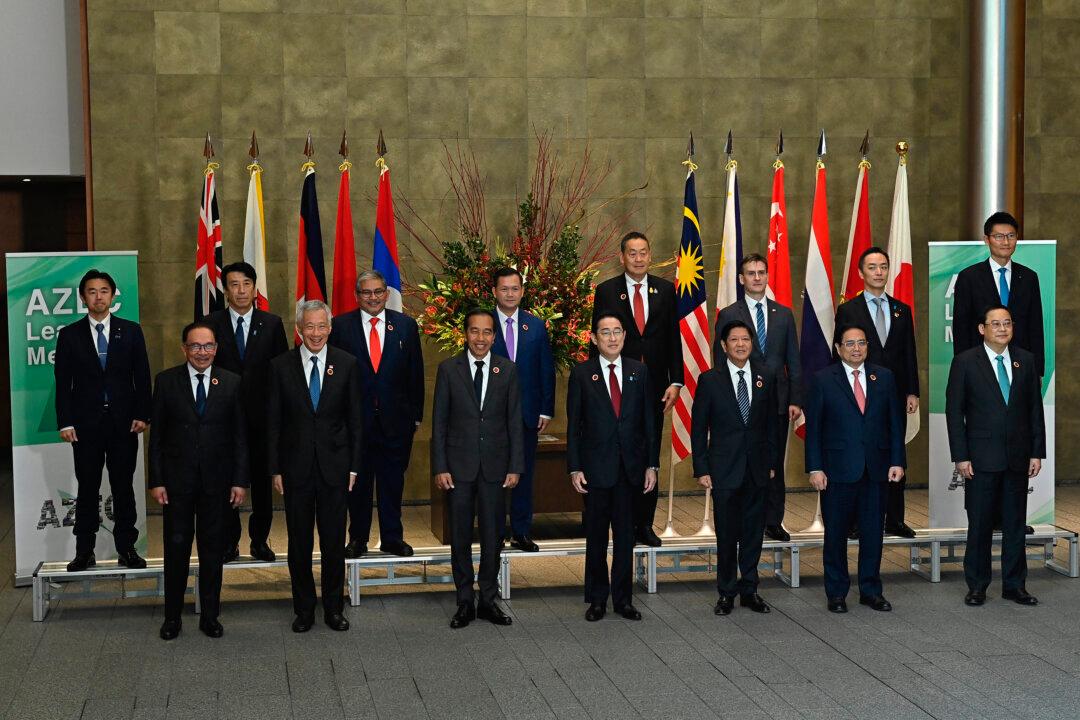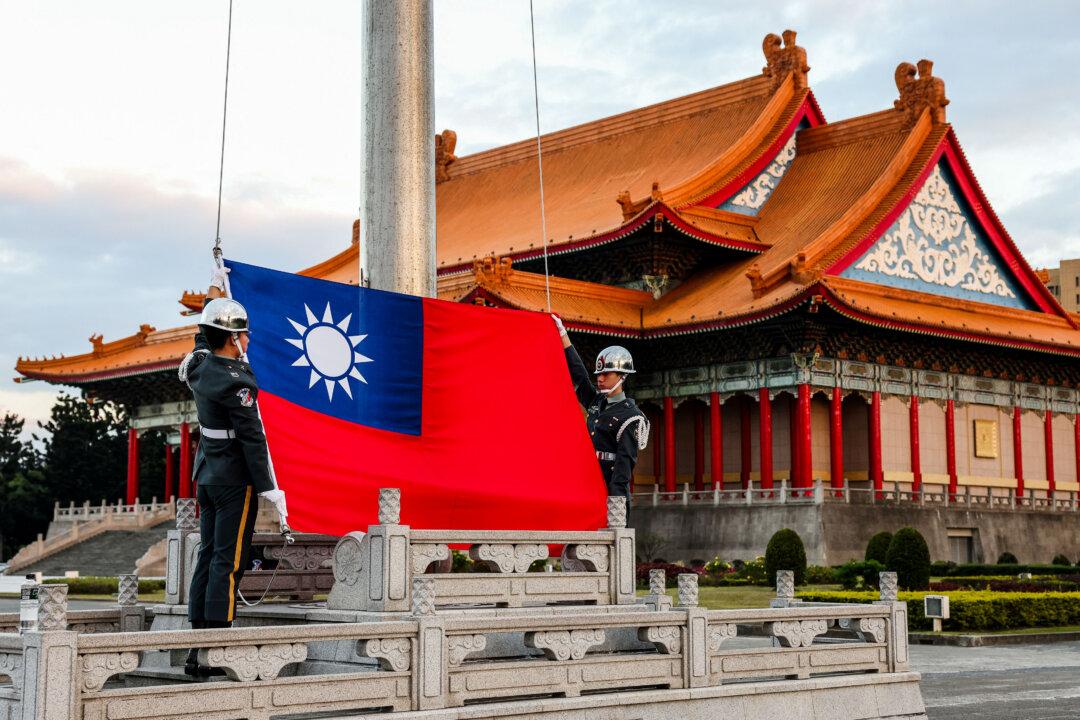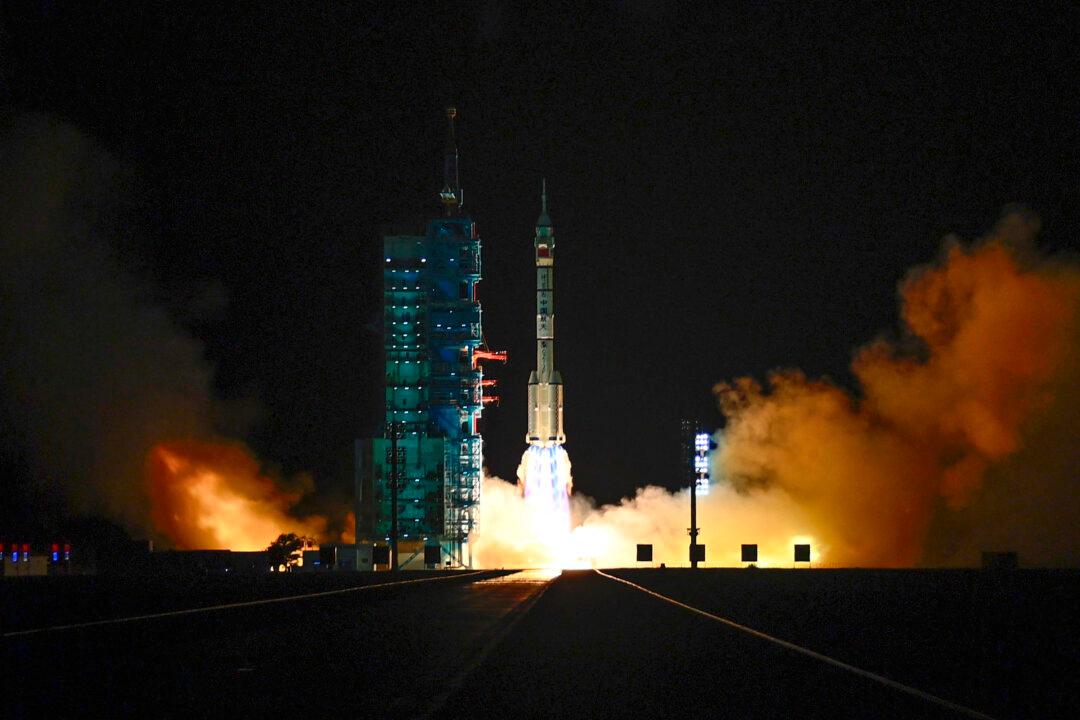Leaders from Japan and the Association of Southeast Asian Nations (ASEAN) emphasized their joint commitment to security and economic cooperation at a special summit on Sunday. The 50th ASEAN-Japan Commemorative Summit, held in Tokyo, signaled a growing bond amid tensions with China in the region.
Addressing the summit, Japanese Prime Minister Fumio Kishida’s description of the Japan-ASEAN bond portrayed it as a “vibrant community” aiming for a “free and open international order.”
Mr. Kishida’s repeated use of the word “community” called to mind the “community of common destiny” into which Beijing hopes to draw the ASEAN nations.
On the first evening of the Dec. 16-18 summit, guests were greeted by the resonating beats of traditional Japanese Taiko drums, as Mr. Kishida hosted a dinner for ASEAN leaders and their spouses at the state guest house, Akasaka Palace, in Tokyo.
In his keynote speech, Mr. Kishida reminisced about the five-decade journey of Japan-ASEAN relations, anchored in “mutual trust.” He highlighted that in a challenging geo-political environment, Japan and ASEAN are collaboratively crafting strategies to address global issues, nurturing societies and economies where “middle-class dreams” can thrive. Their partnership symbolizes a shared “striving for peace and prosperity,” he said, with the aim of establishing a “free and open international order based on the rule of law.”
Throughout the summit, Mr. Kishida engaged in discussions with the leaders of all 10 ASEAN member states: Brunei Darussalam, Burma, Cambodia, Indonesia, Laos, Malaysia, Philippines, Singapore, Thailand, and Vietnam. The summit’s joint statement reaffirmed a mutual commitment to democracy, freedom, rule of law, and human rights, signaling a desire to deepen the Japan-ASEAN strategic partnership, including the cultural, economic, and security realms.
On Dec. 16, Mr. Kishida met with Malaysian Prime Minister Anwar Ibrahim, pledging Japan’s support to bolster Malaysia’s security capabilities. Japan intends to supply equipment worth 400 million yen ($2.8 million), including small drones to Malaysia, as part of a broader security assistance program that includes recent agreements with the Philippines and Bangladesh.
Philippine President Bongbong Marcos, at a press conference in Tokyo on Dec. 16, underscored the shared concerns of the Philippines and Japan regarding threats posed by the CCP. He expressed anticipation for future military exercises with Japan, following a substantial discussion with Mr. Kishida about security agreements.
Vietnamese Prime Minister Pham Minh Chinh, in talks with Japanese business leaders, conveyed Vietnam’s eagerness to collaborate with Japan in sectors such as semiconductor manufacturing and chip design. He stressed that Vietnam, as a stable player in global finance, is keen to enhance its partnership with Japan.
Signifying deepening ties, Japan and Vietnam elevated their relationship to a “Comprehensive Strategic Partnership” on Nov. 27. This alliance focuses on maintaining stable labor forces, boosting trade and investment, and enhancing maritime security, contributing to peace and prosperity in Asia and globally.
Navigating Complex Geopolitical Dynamics: Japan, ASEAN, and the CCP
Japan’s engagement with ASEAN, dating back to 1973, has grown over five decades. The 50th anniversary of this cooperation in 2023 was marked by a series of significant events: seminars in Indonesia (February) and Tokyo (March), the Japan-ASEAN Business Week (June), the Japan-ASEAN Justice Ministers’ Meeting (July), the Japan-ASEAN Tourism Ministers’ Special Dialogue (October), and various other official and civic activities.Japan is pivotal to Asian geopolitics as a democratic counterbalance to the CCP’s growing influence. The 50th-anniversary summit underscored this role, with a particular emphasis on fortifying regional security and forming an alliance to counter the CCP’s maneuvers.
Concurrently, the CCP has intensified its efforts to sway ASEAN, aiming to extend its control and counterbalance the influence of Japan and the United States. The day before the Japan-ASEAN summit in Tokyo, Chinese Foreign Minister Wang Yi met with ambassadors from the ten ASEAN countries in Beijing. He portrayed the ASEAN-China partnership as increasingly close, highlighting Belt and Road initiatives, and positioning China as a steadfast ally in building a “community of common destiny” with ASEAN.
This diplomatic outreach by the CCP was perceived as a strategic move in light of the Tokyo summit.
China’s efforts were also seen at the 26th ASEAN Plus Three summit, held in Indonesia on Sept. 6. At the summit, which was attended by key leaders from Japan, South Korea, and China, former Chinese Premier Li Keqiang advocated against divisive confrontations and the emergence of a “new Cold War.”
However, the CCP’s release of a new map—just a week before the September summit—claiming sovereignty over most of the South China Sea sparked concerns among ASEAN nations, particularly those with territorial disputes with China, such as Malaysia, Vietnam, and the Philippines. Japan also voiced a “strong protest” against the map.
South Korea, though not directly involved in these territorial disputes, has asserted that unilateral actions altering the status quo in the South China Sea are unacceptable and advocated for a rule-based maritime order.
Philippine President Marcos called on ASEAN partners to counter the CCP’s aggressive maritime actions, particularly in the South China Sea.
U.S. Vice President Kamala Harris, also present at the September ASEAN summit, reaffirmed the U.S.’s commitment to the Indo-Pacific region, pledging continued cooperation for mutual security and prosperity. She also announced the establishment of the new U.S.-ASEAN Center in Washington to enhance U.S.-ASEAN ties.
Despite the CCP’s influence, ASEAN nations have shown resistance to its overbearing actions, underlining the United States’ strategic role in the region as a counterbalance to the CCP.
In 2015, ASEAN announced the formation of three key “communities”—Political-Security, Economic, and Socio-Cultural—and adopted the “ASEAN Community Vision 2025” to bolster coordinated cooperation.
In September, ASEAN conducted its first joint military exercise in the South China Sea, the “ASEAN Solidarity Exercise,” focusing on joint maritime patrols, search and rescue, and humanitarian disaster relief. While non-combat in nature, the exercise was a response to the CCP’s maritime expansion and threats to member states’ sovereignty. The Indonesian Chief of Staff, representing the rotating ASEAN chair, announced plans for annual military exercises involving comprehensive war games.
ASEAN’s Evolution and Economic Ties with Japan
The Association of Southeast Asian Nations (ASEAN), established in August 1967, initially comprised Indonesia, Malaysia, the Philippines, Thailand, and Singapore. Brunei joined in 1984, followed by Vietnam, Laos, Myanmar, and Cambodia between 1995 and 1999, rounding up the membership to ten nations, a number that remains unchanged.Originally, ASEAN’s goal was to harness regional strength to resist the spread of communism. However, following the collapse of the Soviet Union in 1991 and shifts in the global political landscape, ASEAN refocused its mission towards fostering economic development and reducing trade barriers among its member countries.
Over the past two decades, ASEAN’s economy has witnessed remarkable growth. In 1999, its GDP was approximately double that of Taiwan; by 2022, this figure had increased to 4.8 times Taiwan’s GDP. Projections suggest that by 2027, ASEAN’s combined GDP could reach $5.2 trillion, potentially equalling Japan’s economic output.
This more than hundredfold growth since its inception has positioned ASEAN at the forefront of global economic expansion, significantly enhancing its role in international affairs.
Japan has consistently sought to strengthen ties with ASEAN, an acknowledgement of the strategic importance of ASEAN’s stance and its geographical position along vital Asian economic sea lanes.
In 2013, then Japanese Prime Minister Shinzo Abe articulated five principles concerning Japan’s approach to ASEAN. These principles extended beyond economic cooperation, emphasizing the joint promotion of universal values such as freedom, democracy, and human rights. Additionally, they stressed the importance of safeguarding the oceans, viewed as a global commons, through adherence to the rule of law rather than the application of force.
ASEAN’s Demographic and Economic Landscape: A Comparative Perspective
The collective population of the ten ASEAN countries is around 670 million, boasting a combined GDP exceeding $3.63 trillion and a per capita GDP of over $5,000.When compared to other major economic unions, ASEAN presents a unique profile: NAFTA’s GDP stands at $24.8 trillion, the EU at $18.35 trillion, and South American trade bloc Mercosur at $5.7 trillion. While ASEAN’s overall economic size and per capita GDP may not rival those of the EU and NAFTA, its larger population grants it a significant demographic edge for future growth.
The 2009 global economic crisis impacted ASEAN’s economic momentum, but the bloc nations began recovering starting in 2010. The pandemic induced a notable downturn in 2020, yet by 2021, all member countries except Brunei showed signs of recovery, with growth rates ranging from 3 percent to 8 percent in 2022.
Japan’s economic and trade ties with ASEAN are notably strong. In 2022, Japan’s trade with ASEAN amounted to 33.2 trillion yen (about $232 billion), representing 15.4 percent of Japan’s total foreign trade. This figure is second only to China (20.3 percent) and exceeds trade volumes with the United States (13.9 percent).
Japanese investment in ASEAN countries in 2022 reached 2,839 billion yen (about $19.8 million), surpassing its 1,207 billion yen (about $8.4 million) investment in China and making ASEAN the largest Japanese investment destination in the region, second only to East Asia.
Japan’s direct investment in ASEAN continues to grow significantly, positioning it as the third-largest investment destination after the United States and the European Union. Among the countries (and economic unions) investing in Japan, ASEAN ranks fourth, following the United States, the European Union, and the United Kingdom.
Japan has also been a key contributor to development assistance in ASEAN, with approximately $3.8 billion in 2021, accounting for 21 percent of the total.
Mr. Kishida, as Foreign Minister (2012-2017) and Prime Minister (since 2021), has made 32 visits to ASEAN countries, reflecting Japan’s commitment to the region.







